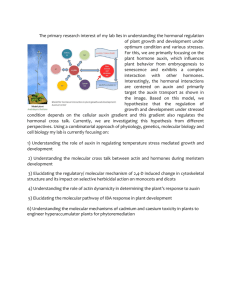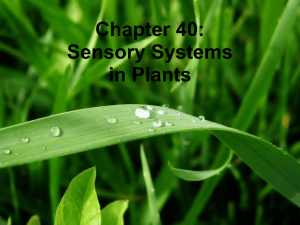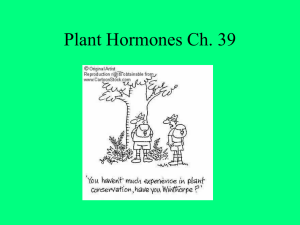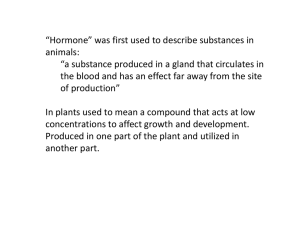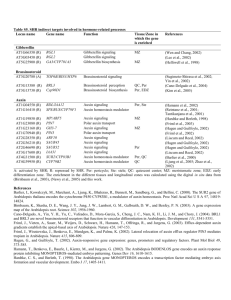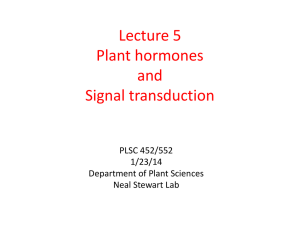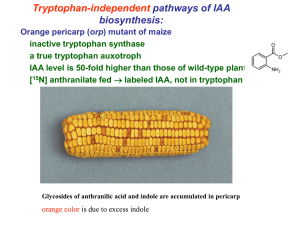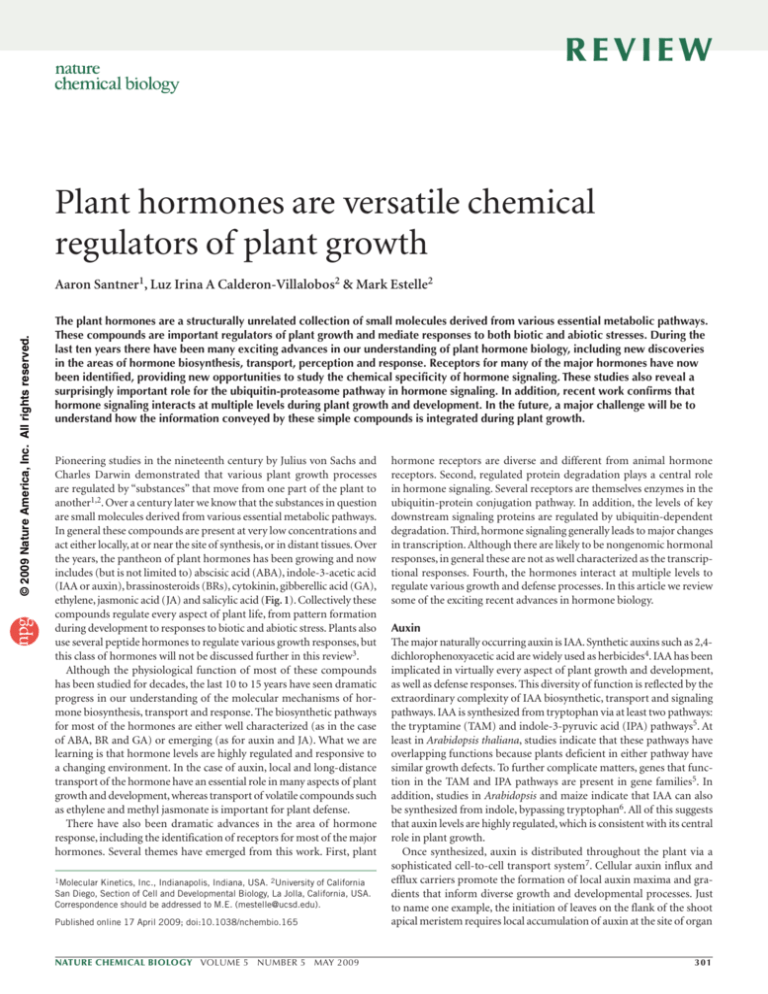
review
Plant hormones are versatile chemical
regulators of plant growth
© 2009 Nature America, Inc. All rights reserved.
Aaron Santner1, Luz Irina A Calderon-Villalobos2 & Mark Estelle2
The plant hormones are a structurally unrelated collection of small molecules derived from various essential metabolic pathways.
These compounds are important regulators of plant growth and mediate responses to both biotic and abiotic stresses. During the
last ten years there have been many exciting advances in our understanding of plant hormone biology, including new discoveries
in the areas of hormone biosynthesis, transport, perception and response. Receptors for many of the major hormones have now
been identified, providing new opportunities to study the chemical specificity of hormone signaling. These studies also reveal a
surprisingly important role for the ubiquitin-proteasome pathway in hormone signaling. In addition, recent work confirms that
hormone signaling interacts at multiple levels during plant growth and development. In the future, a major challenge will be to
understand how the information conveyed by these simple compounds is integrated during plant growth.
Pioneering studies in the nineteenth century by Julius von Sachs and
Charles Darwin demonstrated that various plant growth processes
are regulated by “substances” that move from one part of the plant to
another1,2. Over a century later we know that the substances in question
are small molecules derived from various essential metabolic pathways.
In general these compounds are present at very low concentrations and
act either locally, at or near the site of synthesis, or in distant tissues. Over
the years, the pantheon of plant hormones has been growing and now
includes (but is not limited to) abscisic acid (ABA), indole-3-acetic acid
(IAA or auxin), brassinosteroids (BRs), cytokinin, gibberellic acid (GA),
ethylene, jasmonic acid (JA) and salicylic acid (Fig. 1). Collectively these
compounds regulate every aspect of plant life, from pattern formation
during development to responses to biotic and abiotic stress. Plants also
use several peptide hormones to regulate various growth responses, but
this class of hormones will not be discussed further in this review3.
Although the physiological function of most of these compounds
has been studied for decades, the last 10 to 15 years have seen dramatic
progress in our understanding of the molecular mechanisms of hormone biosynthesis, transport and response. The biosynthetic pathways
for most of the hormones are either well characterized (as in the case
of ABA, BR and GA) or emerging (as for auxin and JA). What we are
learning is that hormone levels are highly regulated and responsive to
a changing environment. In the case of auxin, local and long-distance
transport of the hormone have an essential role in many aspects of plant
growth and development, whereas transport of volatile compounds such
as ethylene and methyl jasmonate is important for plant defense.
There have also been dramatic advances in the area of hormone
response, including the identification of receptors for most of the major
hormones. Several themes have emerged from this work. First, plant
1Molecular Kinetics, Inc., Indianapolis, Indiana, USA. 2University of California
San Diego, Section of Cell and Developmental Biology, La Jolla, California, USA.
Correspondence should be addressed to M.E. (mestelle@ucsd.edu).
Published online 17 April 2009; doi:10.1038/nchembio.165
nature chemical biology volume 5 number 5 MAY 2009
hormone receptors are diverse and different from animal hormone
receptors. Second, regulated protein degradation plays a central role
in hormone signaling. Several receptors are themselves enzymes in the
ubiquitin-protein conjugation pathway. In addition, the levels of key
downstream signaling proteins are regulated by ubiquitin-dependent
degradation. Third, hormone signaling generally leads to major changes
in transcription. Although there are likely to be nongenomic hormonal
responses, in general these are not as well characterized as the transcriptional responses. Fourth, the hormones interact at multiple levels to
regulate various growth and defense processes. In this article we review
some of the exciting recent advances in hormone biology.
Auxin
The major naturally occurring auxin is IAA. Synthetic auxins such as 2,4dichlorophenoxyacetic acid are widely used as herbicides4. IAA has been
implicated in virtually every aspect of plant growth and development,
as well as defense responses. This diversity of function is reflected by the
extraordinary complexity of IAA biosynthetic, transport and signaling
pathways. IAA is synthesized from tryptophan via at least two pathways:
the tryptamine (TAM) and indole-3-pyruvic acid (IPA) pathways5. At
least in Arabidopsis thaliana, studies indicate that these pathways have
overlapping functions because plants deficient in either pathway have
similar growth defects. To further complicate matters, genes that function in the TAM and IPA pathways are present in gene families5. In
addition, studies in Arabidopsis and maize indicate that IAA can also
be synthesized from indole, bypassing tryptophan6. All of this suggests
that auxin levels are highly regulated, which is consistent with its central
role in plant growth.
Once synthesized, auxin is distributed throughout the plant via a
sophisticated cell-to-cell transport system7. Cellular auxin influx and
efflux carriers promote the formation of local auxin maxima and gradients that inform diverse growth and developmental processes. Just
to name one example, the initiation of leaves on the flank of the shoot
apical meristem requires local accumulation of auxin at the site of organ
301
© 2009 Nature America, Inc. All rights reserved.
review
cullin-based E3s are the SCFs, composed of
CUL1, RBX1 (the RING protein), SKP1 (ASK
H
H
H
in plants) and an F-box protein (FBP)13. E3s
N
confer specificity to the pathway, and for SCFH
H
type E3s, specificity is determined by the F-box
OH
Auxin
Ethylene
protein. The Arabidopsis genome encodes more
than 700 F-box proteins, which indicates that
O
SCFs have a prominent role in plants14. Indeed,
O Jasmonic acid
Gibberellin
H
O
SCFs have been implicated in diverse processes
including plant hormone signaling15.
OC
OH
The ubiquitin-proteasome pathway, and an
OH
HO
SCF
in particular, was initially implicated in
H
O
auxin
response with the isolation and charOH
HO
O
H OH
acterization of an auxin-resistant mutant in
Arabidopsis called transport inhibitor response 1
H
(tir1)16. The TIR1 gene encodes an F-box
O
HO
H
Brassinolide
Cytokinin
protein that interacts directly with Aux/IAA
H
proteins (Fig. 2b). Importantly, this binding
O
NH
HO
is enhanced by auxin17–19. Ultimately, strucO
H
H
O
tural studies demonstrated that auxin forms a
N
N
OH
complex with TIR1 and the Aux/IAA proteins,
O
N
thus stabilizing the interaction20. One imporN
H O
OH
tant implication of the structure is that both
Salicylic acid
O
OH
O
TIR1 and the Aux/IAAs appear to contribute to
high-affinity binding of auxin. In this sense, it
H
H
O
may be more appropriate to call TIR1 and the
O
OH
OH
O
Aux/IAA co-receptors. If true, this also implies
that different combinations of F-box protein
Strigolactone
Abscisic acid
and substrate may have unique auxin-binding
characteristics.
The discovery that TIR1 functions as an
auxin receptor was a landmark event. This
Figure 1 Phytohormones regulate all aspects of plant growth and development.
discovery indicates that F-box proteins, and
perhaps other E3s, can function as receptors
primordium formation7. The direction of auxin transport, and hence for small molecules. Indeed, further studies have demonstrated that this
the position of local auxin maxima, is determined by asymmetric local- is the case (see JA signaling below). In addition, the realization that a
ization of transport proteins within cells. Cellular localization is highly small molecule can significantly enhance the E3-substrate binding offers
dynamic and responsive to both developmental and environmental cues. a new approach for the development of drugs that target the ubiquitinBecause of the importance of these processes to plant development, this proteasome pathway20. Beyond the TIR1-Aux/IAA-ARF pathway, our
is an extremely active and exciting area of investigation.
knowledge of the auxin-regulated transcriptional network is limited.
There is evidence for both genomic and nongenomic auxin responses, A DNA sequence that binds ARF proteins, called the Auxin Response
but the mechanisms of auxin-regulated transcription are much better Element (AuxRE), has been identified. However, the function of this
characterized8. Auxin regulates transcription through the action of two element has only been established for a few genes. Further, the promotlarge families of transcription factors called the auxin/indole-3-acetic ers of many auxin response genes don’t have an AuxRE, which suggests
acid (Aux/IAA) proteins and the AUXIN RESPONSE FACTORs (ARFs) that other DNA sequences are probably involved in ARF function21.
(Fig. 2). ARFs directly bind DNA and either activate or inhibit tran- Microarray experiments have shown that auxin rapidly regulates a very
scription depending on the type of ARF9. The Aux/IAA proteins bind large number of genes with diverse cellular functions22. This list includes
to the ARFs and repress auxin-regulated transcription by recruiting a transcription factors that presumably function to regulate downstream
co-repressor called TOPLESS (TPL)10.
gene cascades. In addition, auxin directly stimulates expression of the
Importantly, the Aux/IAA proteins are short-lived and their deg- genes encoding the Aux/IAAs, which indicates that auxin response is subradation requires the ubiquitin-proteasome pathway11. This is a con- ject to a negative feedback loop11. A variety of different cell wall–related
served proteolytic pathway in which proteins destined for degradation genes are also induced by auxin. The proteins encoded by these genes
are tagged with the small protein modifier ubiquitin. Tagged proteins probably facilitate cell wall changes associated with growth. However, it
are typically recognized by the proteasome and degraded. Ubiquitin is should be noted that the function of these genes in auxin response has
covalently conjugated to protein substrates by the sequential activity not been determined.
of three enzymes: the ubiquitin-activating enzyme (E1), the ubiquitinconjugating enzyme (E2) and the ubiquitin protein ligase (E3)12. Most Jasmonic acid
eukaryotes have one or two E1 isoforms, and a larger family of related The oxylipin JA and its metabolites, collectively known as jasmonates,
E2 proteins. The E3 ligases are more diverse and can be divided into are important plant signaling molecules that mediate biotic and abiotic
several classes based on mechanism of action and subunit composition. stress responses as well as aspects of growth and development23. In higher
One large class of E3s is the cullin-based E3s. The best characterized plants, JA is synthesized via the octadecanoid pathway. Once synthesized,
302
volume 5 number 5 MAY 2009 nature chemical biology
review
Like the other phytohormones, GAs play a
major role in diverse growth processes includE1
U
ing seed development, organ elongation and
U
the control of flowering time29. GAs are synAux/IAAs UUU
U
thesized from geranylgeranyl diphosphate
U
E2
in a multi-enzyme pathway that is subject to
Auxin
Aux/IAA
degradation
complex regulation. GA represses expression
TIR1
RBX
of several genes whose products are involved
Low auxin
ASK1
in its biosynthesis and promotes expression of
Cullin
levels
genes involved in GA inactivation29,31. Further,
GA levels are influenced by other hormones
SCF
TIR1/AFBs
TPL
such as auxin and ethylene29.
Aux/IAAs
ARFs
ARFs
GA response is mediated by negative reguEarly auxin
lators
of GA response called DELLA proteins.
responses
The DELLAs are named after the conserved
Auxin-responsive genes
Auxin-responsive genes
N-terminal DELLA domain and also contain
a C-terminal GRAS domain32. GAs promote
Transcriptional activation
Repression of transcription
degradation of DELLA proteins, thus inducing
Figure 2 Auxin signaling in Arabidopsis. SCFTIR1 and related SCF complexes bind auxin and target
the GA transcriptional response33.
Aux/IAA proteins for degradation. (a) At low cellular levels of auxin, transcription of auxin response
The DELLAs accumulate in Arabidopsis and
genes is repressed by the Aux/IAAs. (b) When auxin cellular levels increase, auxin binds to TIR1,
rice mutants mutated in the genes encoding
enhances its affinity for the Aux/IAAs, and promotes their ubiquitination and subsequent degradation,
F-box proteins: sleepy1 (sly1) and gibberellinthus permitting the ARF proteins to promote transcription.
insensitive dwarf2 (gid2), respectively34,35.
Thus, as for auxin and JA, GA appears to regJA can be conjugated to isoleucine to form JA-Ile or converted to the ulate the level of negative regulators through the action of SCF-type
volatile methyl-JA. JA levels increase rapidly in response to a wide range of ligases (Fig. 3). However, unlike Aux/IAA and JAZ proteins, the DELLAs
inductive signals, including herbivory, mechanical wounding and various may not function directly as transcriptional repressors. Recent reports
other abiotic stresses. Increased hormone levels result in extensive changes indicate that DELLAs inhibit cell elongation by binding to the DNA
in defense gene expression. Recent results indicate that JA signaling is binding domain of a transcription factor called PHYTOCHROME
strikingly similar to auxin signaling (Fig. 3). In the case of JA, the hor- INTERACTING FACTOR3 (PIF3), as well as PIF4 and PIF5. This
mone promotes the degradation of transcriptional repressors called JAZ binding prevents the PIF from interacting with promoter elements and
proteins, a process that requires an F-box protein called CORONATINE- stimulating transcription of growth-related genes36,37.
INSENSITIVE1 (COI1)24. Coronatine is a phytotoxin that is structurally
Recently, the GA receptor was identified in rice 38. The
related to JA. The coi1 mutant was recovered in a screen for coronatine GIBBERELLIN INSENSTIVE DWARF1 (GID1) protein is localresistance and is resistant to both coronatine and JA. These results sug- ized in the nucleus and binds biologically active gibberellins 38.
gested that jasmonate response requires SCFCOI1- dependent degradation Three orthologous genes (GID1a, GID1b and GID1c) are present
of repressors, much like SCFTIR1 targets the Aux/IAAs. For JA, the relevant in Arabidopsis39,40. The triple mutant lacking all three proteins is
repressors are called jasmonate ZIM-domain (JAZ) proteins25,26. The JAZ GA-insensitive, which indicates that GA responses require functional
proteins are degraded in a proteasome-dependent manner following jas- GID1 proteins in both rice and Arabidopsis39. The GID1s interact with
monate treatment but are stabilized in the coi1mutant. In addition, the JAZ DELLA proteins in a GA-dependent manner. Further, the DELLAs
proteins bind COI1 both in vitro and in a yeast two-hybrid test25,26. Finally,
radiolabeled coronatine binds to COI1-JAZ complexes with high affinity,
which strongly suggests that COI1 functions as a receptor27. Interestingly,
these studies also demonstrated that JA-Ile is the active molecule in the
E3
SCFTIR1/AFB1–3
SCFCOI1
SCFGID2/SLY
plant rather than JA. These results were confirmed recently in experiments
showing that COI1 is required for JA-Ile or coronatine binding to the
Signal
Auxin
Ile-JA
GID1 + GA
COI1-JAZ complex27,28.
a
b
H
N
26S proteasome
OH
© 2009 Nature America, Inc. All rights reserved.
O
Gibberellins
The GAs are a large family of tetracyclic, diterpenoid growth regulators.
This hormone has a particularly interesting role in modern agriculture.
It was originally isolated in 1938 as a metabolite from the rice fungal
pathogen Gibberella fujikuroi29. Infection of rice by the fungus results
in excessive stem elongation, ultimately causing the plant to fall over
(lodging). In the 1960s and 1970s, the “green revolution” was associated with the adoption of new dwarf varieties. Recent molecular genetic
studies show that these varieties are affected in now well-characterized
components of GA signaling pathways30. Because these varieties have
shorter stems, relatively more of the plants’ resources are used to produce
grain. In addition, the dwarf strains are more resistant to wind and other
severe weather30.
nature chemical biology volume 5 number 5 MAY 2009
Substrates for
Aux/IAAs
degradation
Auxin responses
(lateral root
growth, root
growth inhibition)
JAZs
GAI/RGA/RGLs
JA responses
(defense responses,
reproduction)
GA responses
(seed germination,
stem elongation,
transition from
vegetative growth
to flowering)
Figure 3 Similarities between auxin, JA and GA signaling. SCF-E3–type
ubiquitin ligases promote the ubiquitination and degradation of repressors of
auxin-, JA- and GA-regulated transcription. In the case of auxin and JA, the
hormone directly binds to the SCF and promotes binding and ubiquitylation
of the repressors. In the case of GA, an additional protein (the GA receptor
GID1) facilitates substrate recognition by SCFGID2/SLY.
303
review
O
Cytokinin
NH
H
N
N
N
N
Plasma membrane
AHK2, AHK3,
CRE1/AHK4
P
Feedback
Regulation
P
Nucleus
P
AHPs
AHP6
P
P
Proteolysis
Translocation
© 2009 Nature America, Inc. All rights reserved.
P
Type A
ARRs
CRFs
Translocation
P
Type B
ARRs
Gene
expression
Cytokine-regulated transcription
Figure 4 Model of cytokinin signal transduction. Cytokinin is perceived
by the AHK plasma membrane receptors. Cytokinin signal is further
amplified by phosphorelay events starting from AHKs, which lead to the
activation and subsequent nuclear translocation of AHP proteins. AHP
proteins transfer the phosphoryl group to type A or type B ARR proteins.
The former act as repressors of cytokinin signaling, whereas the latter act
as positive transcriptional regulators of cytokinin-induced genes, including
those encoding type A ARRs. CRF proteins are also activated by cytokinin,
and after translocation to the nucleus they act as activators of cytokininregulated genes.
are better able to interact with SCFGID2/SLY while in a complex with
gibberellin-bound GID1 (refs. 38,39,41). This interaction ultimately
leads to ubiquitination and degradation of the DELLA repressor, thus
promoting GA-mediated transcription.
The structures of rice GID1 and Arabidopsis GID1a support this
model42,43. GID1 is a member of the hormone-sensitive lipase (HSL)
family38. The receptor contains a deep binding pocket whose access is
regulated by a flexible lid42,43. GA binds to the pocket and probably causes
the lid to fold back and interact with the DELLA domain42,43. It is not
clear how complex formation enhances the DELLA-SCFSLY/GID2 interaction, but it may involve a conformational change in the C-terminal GRAS
domain of the DELLA proteins.
Cytokinins
The cytokinins are N6-substituted adenine-based molecules that
were originally discovered in the 1950s by Carlos Miller on the basis
of their ability to promote plant cell division44. They have since been
implicated in a broad range of developmental processes including
germination, root and shoot meristem function and leaf senescence45.
In addition, cytokinin has an important role in the formation of
nitrogen-fixing nodules and other plant-microbe interactions46,47.
In general the first step in cytokinin biosynthesis is the production of N6-(∆2-isopentenyl)adenine (iP) riboside 5′-tri-, 5′-di- or
5′-monophosphate by the enzyme adenosine phosphate-isopentenyltransferase (IPT)48. Active cytokinins are produced by a phosphoribohydrolase enzyme that converts the nucleotide to the free base49. The
regulation of cytokinin levels is complex and involves changes in both
synthesis and metabolism. Recent studies have focused on the complexity
304
of IPT gene regulation and the role of other hormones, including auxin
and ABA, in the regulation of cytokinin biosynthetic genes48.
Cytokinin signaling is remarkably similar to the two-component
signaling systems that are commonplace in bacterial species45. In twocomponent pathways, ligand binding initiates a phosphorelay that
involves both histidine and aspartate kinases. Cytokinin is perceived
by a membrane-associated hybrid kinase that transfers a phosphate to
ARABIDOPSIS HIS PHOSPHOTRANSFER (AHP) proteins (Fig. 4).
The AHPs are translocated into the nucleus where they phosphorylate
ARABIDOPSIS RESPONSE REGULATOR (ARR) proteins. The ARRs
can be either negative (type A ARRs) or positive (type B ARRs) effectors
of cytokinin signaling. Microarray studies indicate that type B ARRs are
direct regulators of the cytokinin transcriptional response. As for auxin,
a large number of genes are regulated by cytokinin22,50. Among these are
members of a family of transcription factor genes called CYTOKININ
RESPONSE FACTORS. Mutants deficient in members of this family
exhibit defects in cytokinin-regulated transcription, which indicates that
these proteins mediate downstream effects of cytokinin on the transcriptional response51.
Ethylene
The gaseous hormone ethylene is best known for its role in fruit ripening. In fact, the Greek philosopher Theophrastus recognized that sycamore figs don’t ripen unless they are wounded by scraping with a metal
tool52. It turns out that wounding causes the formation of ethylene,
which in turn promotes ripening. We now know that ethylene has an
important role in many other developmental processes53. It is synthesized from methionine via the intermediate 1-aminocyclopropane1-carboxylic acid (ACC)54 in a pathway called the Yang cycle, for its
discoverer, Shang Fa Yang55. Ethylene can be synthesized in essentially all
plant organs, although the pathway is regulated by both environmental
and developmental cues such as the onset of fruit ripening. One of the
key enzyme families in the biosynthetic pathway, the ACC synthases, is
a focus of this regulation. For example, auxin induces ethylene synthesis
by directly promoting transcription of ACC synthase genes (ACS). In
addition, various signals modulate ethylene levels by regulating the levels
of the ACS proteins. This is accomplished through the action of another
type of E3 enzyme called a BTB (broad-complex, Tramtrack and brica-brac) complex. In this case, the BTB protein is the specificity factor.
Three BTB proteins, called ETHYLENE OVERPRODUCER1, ETO1LIKE1 (EOL1) and EOL2, are responsible for promoting degradation
of ACS proteins56,57.
Like cytokinin, ethylene is perceived by a two-component protein
kinase receptor53. In this case, however, the receptor is localized to the
endoplasmic reticulum membrane. In the absence of ethylene, the receptor negatively regulates ethylene signaling via a Raf-like protein kinase
called CONSTITUTIVE TRIPLE RESPONSE1 (CTR1). CTR1 in turn
negatively regulates a second membrane protein called ETHYLENE
INSENSITIVE2 (EIN2). Through an unknown mechanism, EIN2 activates members of a small family of transcription factors including EIN3.
As for the other hormones, the ubiquitin pathway has an important role
in ethylene signaling53. Both EIN2 and EIN3 levels are controlled by E3
ligases. In the absence of ethylene, SCFETP1/2 (with the F-box protein
EIN2 TARGETING PROTEIN1 (ETP1) or ETP2) promotes degradation of EIN2, thus reducing the ethylene response58. Ethylene acts to
decrease ETP gene expression, thus permitting the accumulation of EIN2.
Similarly, another pair of F-box proteins called EIN3-BINDING F-BOX1
(EBF1) and EBF2 promote degradation of EIN3 at low levels of hormone.
As hormone levels increase, EIN3 degradation decreases and ethyleneregulated transcription is stimulated. Finally, EBF1 and EBF2 RNA levels
are regulated by an exoRNase called EIN5, or XRN4 (ref. 53).
volume 5 number 5 MAY 2009 nature chemical biology
© 2009 Nature America, Inc. All rights reserved.
review
Abscisic acid
ABA is an isoprenoid compound associated with seed dormancy,
drought responses and other growth processes59,60. The ABA biosynthetic pathway was defined through genetic studies of mutants with seed
dormancy defects, primarily in maize and Arabidopsis. It is thought that
nearly all of the genes in the pathway have now been identified59. ABA
levels are regulated by a variety of environmental conditions. Particular
attention has been paid to changes in ABA levels during seed maturation
and in response to drought conditions. In both processes, changes in biosynthesis and catabolism appear to be important for ABA regulation.
Although several candidate ABA receptors have been proposed
in recent years, these reports are controversial. Magnesium protoporphyrin-IX chelatase H subunit (CHLH; also called GENOMES
UNCOUPLED5 or GUN5 in Arabidopsis) is an unconventional site
of hormone perception61. This protein is localized to chloroplasts
and was reported to have specific ABA-binding activity. Plants with
decreased CHLH levels have ABA-insensitive germination and stomatal
aperture phenotypes, whereas plants overexpressing CHLH are ABAhypersenstive in these assays. However, at this point it is unclear how
CHLH mediates these responses. Further, a recent study reported that
CHLH from barley does not bind ABA, and that mutants with reduced
CHLH levels do not display an ABA-related phenotype, thus calling into
question the function of this protein as an ABA receptor62.
A second report of a candidate ABA receptor involves a putative
G protein–coupled receptor from Arabidopsis called G-PROTEIN
COUPLED RECEPTOR2 (GCR2)63. This finding is also controversial
because it is not clear that GCR2 has a transmembrane domain64. In
addition, genetic analysis of the GCR2 family failed to detect an ABArelated phenotype65,66. At this point, GCR2 appears unlikely to function
as an ABA receptor.
The most recent report of ABA receptor function concerns another
pair of G protein–coupled receptors called GTG1 (GPCR-type G protein
1) and GTG2 (ref. 67). Plants lacking both GTG1 and GTG2 are deficient
in ABA responses during germination, flowering, root elongation and
stomatal closure67. In addition, both proteins bind biologically active
ABA in vitro. Whether or not GTG1 and GTG2 are the only ABA receptors is a question for the future. ABA responses are diverse, and it is
possible that this diversity requires multiple sites of perception68.
ABA signal transduction pathways are complex and involve a variety
of small molecules and proteins. Two protein phosphatase 2C proteins
called ABI1 and ABI2 have a central role in ABA response, as mutations
in either gene affect all ABA responses. In addition, a variety of kinases,
RNA-modifying enzymes and transcription factors have been proposed
to function in ABA signaling69,70. In the guard cell, Ca2+, ROS and NO
have all been implicated in ABA promotion of stomatal closing69. Finally,
the ubiquitin-proteasome pathway is known to be important. Two RING
E3 ligases, ABI3-interacting protein (AIP2) and Keep on Going (KEG),
promote normal ABA signaling by regulating the abundance of ABAresponsive transcription factors, namely ABA-insensitive 3 (ABI3) and
ABI5 (refs. 71,72).
Salicylic acid
Salicylic acid (SA) is best known for its central role in plant defense
response73,74. SA is synthesized from chorismate via isochorismate.
Infection of the plants by a broad range of pathogens results in an
increase in SA levels both at the site of infection and in distant tissues.
Many of the details of SA signaling have not been worked out, including
the mechanism of SA perception. However, it is clear that SA response
depends on a protein called NONEXPRESSER OF PR genes (NPR1).
When SA levels increase, NPR1 is translocated into the nucleus where
it promotes the transcription of a large family of PATHOGENESIS
nature chemical biology volume 5 number 5 MAY 2009
RELATED (PR) genes. Some PR proteins have antimicrobial activity,
but in general the function of these proteins has not been clearly defined.
The precise mechanism of NPR1 function is also not clear. Interestingly,
NPR1 is a member of the BTB domain family of proteins, and like ETO1
it is probably a subunit in an E3 ligase74,75, which implies that SA action
also involves regulated protein degradation.
One of the most interesting aspects of SA biology is its role in systemic
acquired resistance (SAR)74. SAR is a defense pathway that provides
systemic protection to a broad range of pathogens. As mentioned above,
pathogen attack results in an increase in SA levels at the site of infection
and at distant sites. The response appears to require the synthesis of
the volatile compound methyl salicylate (MeSA) at the infection site.
MeSA moves to other parts of the plant, where it is converted to SA by
the protein SA BINDING PROTEIN2 (SABP2).
Interactions between hormones
Abundant physiological data suggest that all plant hormones interact
with one or more additional hormones. Depending on context, hormone interaction can involve changes in hormone level or response.
For example, several genes required for auxin biosynthesis are under
transcriptional control of ethylene76–78, while auxin can also influence ethylene biosynthesis by inducing expression of genes encoding
ACC synthase79.
Hormone interactions also occur at the level of hormone distribution. A good illustration of this type of crosstalk is the opposing action
of auxin and cytokinin during lateral root initiation. It is widely known
that polar auxin transport and the establishment of an auxin gradient
is a very important determinant of plant growth and morphological
patterning80. During root development, auxin promotes lateral root
initiation while cytokinin opposes this response. One way that cytokinin does this is to influence the expression of the PINFORMED (PIN)
auxin efflux carrier genes81. At least five PIN genes work collectively to
establish auxin gradients in roots by controlling the direction of polarauxin transport82. By reducing PIN expression, cytokinin disrupts local
auxin gradient formation in lateral root founder cells, thereby inhibiting
lateral root initiation81.
Hormonal signaling pathways are also known to interact at the level
of gene expression. For example, studies show that there is significant
overlap between auxin- and brassinosteroid-responsive gene sets21,83.
Generally, common target genes repressed by auxin are also repressed by
brassinosteroids, and genes induced by auxin are induced by brassinosteroids, which suggests coordination between the signaling pathways.
Furthermore, transcriptional profiling revealed that very few auxin
response genes responded normally to auxin in the BR-deficient mutant
brevis radix (brx)84. Conversely, many brassinosteroid-responsive genes
are misregulated in the yucca mutant that overproduces auxin21. Taken
together, the data suggest that auxin and brassinosteroid signaling pathways partially converge on a set of common target genes.
Control over key components of signaling pathways by other
hormone signals is another common example of crosstalk strategy.
As described above, DELLA proteins are central regulators of the
GA-mediated signaling pathway and appear to be a common crosstalk node for several interacting hormones including auxin, ethylene
and ABA85. GA signaling during root elongation is known to require
auxin, as disruption of polar auxin transport or signaling diminishes
the effects of GA on root elongation86. The attenuated growth response
corresponds with reduced RGA degradation in root cells. These observations indicate that auxin promotes the GA-induced destabilization
of some of the DELLA proteins to affect GA responses86. Similarly,
ethylene and ABA may also target DELLA proteins to exert antagonistic
actions with GA during root growth85,87.
305
© 2009 Nature America, Inc. All rights reserved.
review
Emerging chemical signals
It seems likely that the signaling compounds described here are not
the end of the story. Given the metabolic complexity of plants, there
are probably more, perhaps many more, small molecules with signaling function. Perhaps the most striking example of this is the recent
discovery that the carotenoid-derived molecule strigolactone is a
shoot branching hormone88–90. It has been known for many years that
auxin synthesized in the apex of the plant inhibits the growth of lateral
branches. This phenomenon is called apical dominance. More recently,
genetic studies in Arabidopsis, pea, petunia and rice have shown that a
signal originating in the root also inhibits shoot branching88. This signal
turns out to be strigolactone. The mechanism of strigolactone action
is still unclear, but some details are starting to emerge. Experiments
in Arabidopsis indicate that strigolactone inhibits auxin transport,
which suggests a complex interaction between these two hormones91.
Further, one of the genes required for strigolactone-dependent inhibition of branching, MORE AXILLARY BRANCHES (MAX2), encodes an
F-box protein, which indicates that once again, protein degradation is
an important component of this regulatory system88,92. In addition to
strigolactone, there is accumulating evidence that nitric oxide has a role
in plant defense and perhaps in aspects of growth73,93.
Conclusions and future directions
During the last ten years, our understanding of the molecular
mechanisms of hormone biosynthesis, perception and response has
improved dramatically. Knowledge of hormone metabolic and transport pathways will lead to new opportunities to manipulate hormone
levels and thus regulate plant growth. Receptors for many of the hormone classes have been identified, thus leading to exciting new models of hormone perception. Detailed knowledge of receptor function
may stimulate the development of new plant growth regulators 94.
Similarly, many downstream signaling components have been identified. In the future a major challenge will be to understand how these
signaling pathways are integrated during plant growth. For example,
we know that auxin, GA and BR all promote cell elongation in the
plant stem. However, the relative contribution of each signaling pathway to growth regulation in response to changes in the environment is
uncertain. Similarly, it is not known whether cell elongation involves
the same set of genes for each hormone signal. Finally, as we learn
more about the mechanisms of hormone action, our ability to generate predictive models of plant growth will improve. Already robust
models for auxin-dependent regulation of shoot and root growth
have been developed95–99. Ultimately we can expect these models to
incorporate the diversity of hormone and environmental signals and
thus enable an integrated view of plant growth and development.
ACKNOWLEDGMENTS
The authors’ work is supported by grants to M.E. from the US National Institutes
of Health (GM 43644), the US Department of Energy (De-FG02-02ER15312) and
the US National Science Foundation (MCB-0519970, IOS-0849069).
Published online at http://www.nature.com/naturechemicalbiology/
Reprints and permissions information is available online at http://npg.nature.com/
reprintsandpermissions/
1. Sachs, J. Stoff und Form der Pflanzenorgane. Arb. Bot. Inst. Würzburg 2, 452–488
(1880).
2. Darwin, C. The Power of Movement in Plants (John Murray, London, 1880).
3. Jun, J.H., Fiume, E. & Fletcher, J.C. The CLE family of plant polypeptide signaling
molecules. Cell. Mol. Life Sci. 65, 743–755 (2008).
4. Davies, P.J. in Plant Hormones Physiology, Biochemistry and Molecular Biology
(ed. Davies, P.J.) 1–12 (Kluwer Academic Publishers, Dordrecht, The Netherlands,
1995).
5. Strader, L.C. & Bartel, B. A new path to auxin. Nat. Chem. Biol. 4, 337–339
(2008).
306
6. Woodward, A.W. & Bartel, B. Auxin: regulation, action, and interaction. Ann. Bot.
(Lond.) 95, 707–735 (2005).
7. Vieten, A., Sauer, M., Brewer, P.B. & Friml, J. Molecular and cellular aspects of auxintransport-mediated development. Trends Plant Sci. 12, 160–168 (2007).
8. Badescu, G.O. & Napier, R.M. Receptors for auxin: will it all end in TIRs? Trends Plant
Sci. 11, 217–223 (2006).
9. Guilfoyle, T.J. & Hagen, G. Auxin response factors. Curr. Opin. Plant Biol. 10, 453–460
(2007).
10.Szemenyei, H., Hannon, M. & Long, J.A. TOPLESS mediates auxin-dependent transcriptional repression during Arabidopsis embryogenesis. Science 319, 1384–1386
(2008).
11.Mockaitis, K. & Estelle, M. Auxin receptors and plant development: a new signaling
paradigm. Annu. Rev. Cell Dev. Biol. 24, 55–80 (2008).
12.Pickart, C.M. Mechanisms underlying ubiquitination. Annu. Rev. Biochem. 70, 503–
533 (2001).
13.Deshaies, R.J. SCF and Cullin/Ring H2-based ubiquitin ligases. Annu. Rev. Cell Dev.
Biol. 15, 435–467 (1999).
14.Gagne, J.M., Downes, B.P., Shiu, S.H. Durshi, A.M. & Vierstra, R.D. The F-box subunit
of the SCF E3 complex is encoded by a diverse superfamily of genes in Arabidopsis.
Proc. Natl. Acad. Sci. USA 99, 11519–11524 (2002).
15.Lechner, E., Achard, P., Vansiri, A., Potuschak, T. & Genschik, P. F-box proteins everywhere. Curr. Opin. Plant Biol. 9, 631–638 (2006).
16.Ruegger, M. et al. The TIR1 protein of Arabidopsis functions in auxin response and is
related to human SKP2 and yeast grr1p. Genes Dev. 12, 198–207 (1998).
17.Gray, W.M., Kepinski, S., Rouse, D., Leyser, O. & Estelle, M. Auxin regulates SCFTIR1dependent degradation of AUX/IAA proteins. Nature 414, 271–276 (2001).
18.Dharmasiri, N., Dharmasiri, S., Jones, A.M. & Estelle, M. Auxin action in a cell-free
system. Curr. Biol. 13, 1418–1422 (2003).
19.Kepinski, S. & Leyser, O. Auxin-induced SCFTIR1-Aux/IAA interaction involves stable
modification of the SCFTIR1 complex. Proc. Natl. Acad. Sci. USA 101, 12381–12386
(2004).
20.Tan, X. et al. Mechanism of auxin perception by the TIR1 ubiquitin ligase. Nature 446,
640–645 (2007).
21.Nemhauser, J.L., Mockler, T.C. & Chory, J. Interdependency of brassinosteroid and
auxin signaling in Arabidopsis. PLoS Biol. 2, E258 (2004).
22.Peng, Z.Y. et al. Arabidopsis Hormone Database: a comprehensive genetic and phenotypic information database for plant hormone research in Arabidopsis. Nucleic Acids
Res. 37, D975–D982 (2009).
23.Wasternack, C. Jasmonates: an update on biosynthesis, signal transduction and action
in plant stress response, growth and development. Ann. Bot. (Lond.) 100, 681–697
(2007).
24.Xie, D.X., Feys, B.F., James, S., Nieto-Rostro, M. & Turner, J.G. COI1: an Arabidopsis
gene required for jasmonate-regulated defense and fertility. Science 280, 1091–1094
(1998).
25.Thines, B. et al. JAZ repressor proteins are targets of the SCF(COI1) complex during
jasmonate signalling. Nature 448, 661–665 (2007).
26.Chini, A. et al. The JAZ family of repressors is the missing link in jasmonate signalling.
Nature 448, 666–671 (2007).
27.Melotto, M. et al. A critical role of two positively charged amino acids in the Jas motif of
Arabidopsis JAZ proteins in mediating coronatine- and jasmonoyl isoleucine-dependent
interactions with the COI1 F-box protein. Plant J. 55, 979–988 (2008).
28.Katsir, L., Schilmiller, A.L., Staswick, P.E., He, S.Y. & Howe, G.A. COI1 is a critical
component of a receptor for jasmonate and the bacterial virulence factor coronatine.
Proc. Natl. Acad. Sci. USA 105, 7100–7105 (2008).
29.Yamaguchi, S. Gibberellin metabolism and its regulation. Annu. Rev. Plant Biol. 59,
225–251 (2008).
30.Peng, J. et al. ‘Green revolution’ genes encode mutant gibberellin response modulators.
Nature 400, 256–261 (1999).
31.Fleet, C.M. & Sun, T.P.A. DELLAcate balance: the role of gibberellin in plant morphogenesis. Curr. Opin. Plant Biol. 8, 77–85 (2005).
32.Schwechheimer, C. Understanding gibberellic acid signaling–are we there yet? Curr.
Opin. Plant Biol. 11, 9–15 (2008).
33.Itoh, H., Matsuoka, M. & Steber, C.M. A role for the ubiquitin-26S-proteasome pathway
in gibberellin signaling. Trends Plant Sci. 8, 492–497 (2003).
34.McGinnis, K.M. et al. The Arabidopsis SLEEPY1 gene encodes a putative F-box subunit
of an SCF E3 ubiquitin ligase. Plant Cell 15, 1120–1130 (2003).
35.Sasaki, A. et al. Accumulation of phosphorylated repressor for gibberellin signaling in
an F-box mutant. Science 299, 1896–1898 (2003).
36.Feng, S. et al. Coordinated regulation of Arabidopsis thaliana development by light and
gibberellins. Nature 451, 475–479 (2008).
37.de Lucas, M. et al. A molecular framework for light and gibberellin control of cell
elongation. Nature 451, 480–484 (2008).
38.Ueguchi-Tanaka, M. et al. GIBBERELLIN INSENSITIVE DWARF1 encodes a soluble
receptor for gibberellin. Nature 437, 693–698 (2005).
39.Griffiths, J. et al. Genetic characterization and functional analysis of the GID1 gibberellin receptors in Arabidopsis. Plant Cell 18, 3399–3414 (2006).
40.Nakajima, M. et al. Identification and characterization of Arabidopsis gibberellin receptors. Plant J. 46, 880–889 (2006).
41.Willige, B.C. et al. The DELLA domain of GA INSENSITIVE mediates the interaction
with the GA INSENSITIVE DWARF1A gibberellin receptor of Arabidopsis. Plant Cell
19, 1209–1220 (2007).
42.Shimada, A. et al. Structural basis for gibberellin recognition by its receptor GID1.
Nature 456, 520–523 (2008).
volume 5 number 5 MAY 2009 nature chemical biology
© 2009 Nature America, Inc. All rights reserved.
review
43.Murase, K., Hirano, Y., Sun, T.P. & Hakoshima, T. Gibberellin-induced DELLA recognition by the gibberellin receptor GID1. Nature 456, 459–463 (2008).
44.Miller, C., Skoog, F., Saltza, M.V. & Strong, M. Kinetic, a cell division factor from
deoxyribonucleic acid. J. Am. Chem. Soc. 77, 1392 (1955).
45.To, J.P. & Kieber, J.J. Cytokinin signaling: two-components and more. Trends Plant
Sci. 13, 85–92 (2008).
46.Murray, J.D. et al. A cytokinin perception mutant colonized by Rhizobium in the
absence of nodule organogenesis. Science 315, 101–104 (2007).
47.Frugier, F., Kosuta, S., Murray, J.D., Crespi, M. & Szczyglowski, K. Cytokinin: secret
agent of symbiosis. Trends Plant Sci. 13, 115–120 (2008).
48.Sakakibara, H. Cytokinins: activity, biosynthesis, and translocation. Annu. Rev. Plant
Biol. 57, 431–449 (2006).
49.Kurakawa, T. et al. Direct control of shoot meristem activity by a cytokinin-activating
enzyme. Nature 445, 652–655 (2007).
50.Rashotte, A.M., Carson, S.D., To, J.P. & Kieber, J.J. Expression profiling of cytokinin
action in Arabidopsis. Plant Physiol. 132, 1998–2011 (2003).
51.Rashotte, A.M. et al. A subset of Arabidopsis AP2 transcription factors mediates
cytokinin responses in concert with a two-component pathway. Proc. Natl. Acad. Sci.
USA 103, 11081–11085 (2006).
52.Theologis, A. One rotten apple spoils the whole bushel: the role of ethylene in fruit
ripening. Cell 70, 181–184 (1992).
53.Kendrick, M.D. & Chang, C. Ethylene signaling: new levels of complexity and regulation. Curr. Opin. Plant Biol. 11, 479–485 (2008).
54.De Paepe, A. & Van der Straeten, D. Ethylene biosynthesis and signaling: an overview.
Vitam. Horm. 72, 399–430 (2005).
55.Adams, D.O. & Yang, S.F. Ethylene biosynthesis: identification of 1-aminocyclopropane-1-carboxylic acid as an intermediate in the conversion of methionine to ethylene.
Proc. Natl. Acad. Sci. USA 76, 170–174 (1979).
56.Wang, K.L., Yoshida, H., Lurin, C. & Ecker, J.R. Regulation of ethylene gas biosynthesis by the Arabidopsis ETO1 protein. Nature 428, 945–950 (2004).
57.Christians, M.J. et al. The BTB ubiquitin ligases ETO1, EOL1 and EOL2 act collectively
to regulate ethylene biosynthesis in Arabidopsis by controlling type-2 ACC synthase
levels. Plant J. 57, 332–345 (2009).
58.Qiao, H., Chang, K.N., Yazaki, J. & Ecker, J.R. Interplay between ethylene, ETP1/ETP2
F-box proteins, and degradation of EIN2 triggers ethylene responses in Arabidopsis.
Genes Dev. 23, 512–521 (2009).
59.Nambara, E. & Marion-Poll, A. Abscisic acid biosynthesis and catabolism. Annu. Rev.
Plant Biol. 56, 165–185 (2005).
60.Israelsson, M. et al. Guard cell ABA and CO2 signaling network updates and Ca2+
sensor priming hypothesis. Curr. Opin. Plant Biol. 9, 654–663 (2006).
61.Shen, Y.Y. et al. The Mg-chelatase H subunit is an abscisic acid receptor. Nature 443,
823–826 (2006).
62.Muller, A.H. & Hansson, M. The barley magnesium chelatase 150-kDa subunit is not an
abscisic acid receptor. Plant Physiol. published online, doi:10.1104/pp.109.135277
(28 January 2009).
63.Liu, X. et al. A G protein-coupled receptor is a plasma membrane receptor for the plant
hormone abscisic acid. Science 315, 1712–1716 (2007).
64.Johnston, C.A. et al. Comment on “A G protein coupled receptor is a plasma membrane
receptor for the plant hormone abscisic acid”. Science 318, 914, author reply 914
(2007).
65.Guo, J., Zeng, Q., Emami, M., Ellis, B.E. & Chen, J.G. The GCR2 gene family is not
required for ABA control of seed germination and early seedling development in
Arabidopsis. PLoS One 3, e2982 (2008).
66.Gao, Y. et al. Genetic characterization reveals no role for the reported ABA receptor, GCR2, in ABA control of seed germination and early seedling development in
Arabidopsis. Plant J. 52, 1001–1013 (2007).
67.Pandey, S., Nelson, D.C. & Assmann, S.M. Two novel GPCR-type G proteins are
abscisic acid receptors in Arabidopsis. Cell 136, 136–148 (2009).
68.McCourt, P. & Creelman, R. The ABA receptors–we report you decide. Curr. Opin. Plant
Biol. 11, 474–478 (2008).
69.Hirayama, T. & Shinozaki, K. Perception and transduction of abscisic acid signals: keys
to the function of the versatile plant hormone ABA. Trends Plant Sci. 12, 343–351
(2007).
70.Finkelstein, R., Reeves, W., Ariizumi, T. & Steber, C. Molecular aspects of seed dormancy. Annu. Rev. Plant Biol. 59, 387–415 (2008).
71.Stone, S.L., Williams, L.A., Farmer, L.M., Vierstra, R.D. & Callis, J. KEEP ON GOING,
nature chemical biology volume 5 number 5 MAY 2009
a RING E3 ligase essential for Arabidopsis growth and development, is involved in
abscisic acid signaling. Plant Cell 18, 3415–3428 (2006).
72.Zhang, X., Garreton, V. & Chua, N.H. The AIP2 E3 ligase acts as a novel negative regulator
of ABA signaling by promoting ABI3 degradation. Genes Dev. 19, 1532–1543 (2005).
73.Vlot, A.C., Klessig, D.F. & Park, S.W. Systemic acquired resistance: the elusive
signal(s). Curr. Opin. Plant Biol. 11, 436–442 (2008).
74.Durrant, W.E. & Dong, X. Systemic acquired resistance. Annu. Rev. Phytopathol. 42,
185–209 (2004).
75.Gingerich, D.J. et al. Cullins 3a and 3b assemble with members of the broad complex/
tramtrack/bric-a-brac (BTB) protein family to form essential ubiquitin-protein ligases
(E3s) in Arabidopsis. J. Biol. Chem. 280, 18810–18821 (2005).
76.Stepanova, A.N., Hoyt, J.M., Hamilton, A.A. & Alonso, J.M. A Link between ethylene
and auxin uncovered by the characterization of two root-specific ethylene-insensitive
mutants in Arabidopsis. Plant Cell 17, 2230–2242 (2005).
77.Stepanova, A.N. et al. TAA1-mediated auxin biosynthesis is essential for hormone
crosstalk and plant development. Cell 133, 177–191 (2008).
78.Tao, Y. et al. Rapid synthesis of auxin via a new tryptophan-dependent pathway is
required for shade avoidance in plants. Cell 133, 164–176 (2008).
79.Tsuchisaka, A. & Theologis, A. Unique and overlapping expression patterns among
the Arabidopsis 1-amino-cyclopropane-1-carboxylate synthase gene family members.
Plant Physiol. 136, 2982–3000 (2004).
80.Feraru, E. & Friml, J. PIN polar targeting. Plant Physiol. 147, 1553–1559 (2008).
81.Laplaze, L. et al. Cytokinins act directly on lateral root founder cells to inhibit root
initiation. Plant Cell 19, 3889–3900 (2007).
82.Blilou, I. et al. The PIN auxin efflux facilitator network controls growth and patterning
in Arabidopsis roots. Nature 433, 39–44 (2005).
83.Goda, H. et al. Comprehensive comparison of auxin-regulated and brassinosteroidregulated genes in Arabidopsis. Plant Physiol. 134, 1555–1573 (2004).
84.Mouchel, C.F., Osmont, K.S. & Hardtke, C.S. BRX mediates feedback between
brassinosteroid levels and auxin signalling in root growth. Nature 443, 458–461
(2006).
85.Weiss, D. & Ori, N. Mechanisms of cross talk between gibberellin and other hormones.
Plant Physiol. 144, 1240–1246 (2007).
86.Fu, X. & Harberd, N.P. Auxin promotes Arabidopsis root growth by modulating gibberellin response. Nature 421, 740–743 (2003).
87.Achard, P., Vriezen, W.H., Van Der Straeten, D. & Harberd, N.P. Ethylene regulates
Arabidopsis development via the modulation of DELLA protein growth repressor function. Plant Cell 15, 2816–2825 (2003).
88.Leyser, O. The control of shoot branching: an example of plant information processing.
Plant Cell Environ. published online, doi:10.1111/j.1365–3040.2009.01930.x (1
January 2009).
89.Gomez-Roldan, V. et al. Strigolactone inhibition of shoot branching. Nature 455,
189–194 (2008).
90.Umehara, M. et al. Inhibition of shoot branching by new terpenoid plant hormones.
Nature 455, 195–200 (2008).
91.Bennett, T. et al. The Arabidopsis MAX pathway controls shoot branching by regulating
auxin transport. Curr. Biol. 16, 553–563 (2006).
92.Stirnberg, P., van De Sande, K. & Leyser, H.M. MAX1 and MAX2 control shoot lateral
branching in Arabidopsis. Development 129, 1131–1141 (2002).
93.Flores, T. et al. Arginase-negative mutants of Arabidopsis exhibit increased nitric oxide
signaling in root development. Plant Physiol. 147, 1936–1946 (2008).
94.Hayashi, K. et al. Small-molecule agonists and antagonists of F-box protein-substrate
interactions in auxin perception and signaling. Proc. Natl. Acad. Sci. USA 105,
5632–5637 (2008).
95.Jönsson, H., Heisler, M.G., Shapiro, B.E., Meyerowitz, E.M. & Mjolsness, E. An auxindriven polarized transport model for phyllotaxis. Proc. Natl. Acad. Sci. USA 103,
1633–1638 (2006).
96.Hamant, O. et al. Developmental patterning by mechanical signals in Arabidopsis.
Science 322, 1650–1655 (2008).
97.Grieneisen, V.A., Xu, J., Maree, A.F., Hogeweg, P. & Scheres, B. Auxin transport is
sufficient to generate a maximum and gradient guiding root growth. Nature 449,
1008–1013 (2007).
98.Kramer, E.M., Draye, X. & Bennett, M.J. Modelling root growth and development. SEB
Exp. Biol. Ser. 61, 195–211 (2008).
99.Smith, R.S. et al. A plausible model of phyllotaxis. Proc. Natl. Acad. Sci. USA 103,
1301–1306 (2006).
307

